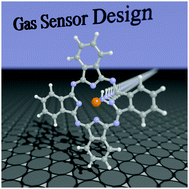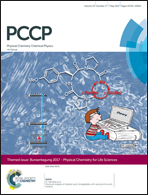Rovibrational spectroscopic constants of the interaction between ammonia and metallo-phthalocyanines: a theoretical protocol for ammonia sensor design†
Abstract
In the present contribution, we develop an adapted theoretical approach based on DFT calculations (B3LYP functional) and solution of the nuclear Schrödinger equation by using the Discrete Variable Representation method to model the interaction of ammonia with metallo-phthalocyanines (MPcs, where M = Fe2+, Co2+, Ni2+, Cu2+ or Zn2+). This approach is intended to be a general protocol for the rational design of chemical sensors. The as-obtained binding energy curves, obtained from ab initio points, permitted us to calculate rovibrational energies and spectroscopic constants, as well as to establish the relative population of rovibrational states in different types of MPc–NH3 thermodynamic systems. Simulated binding energy curves show that the binding energy in MPc–NH3 systems is dependent on the type of M central ion, decreasing in the order FePc > ZnPc > CoPc > CuPc > NiPc, with values spanning from −170 to −16 kJ mol−1. Also, MPc–NH3 systems have at least 16 rovibrational levels, which confirms that they are all bound systems (chemically or physically). Despite that, only the interaction between ammonia and FePc, CoPc or ZnPc is spontaneous within the studied temperature range (200–700 K). NiPc and CuPc show a change between spontaneous and non-spontaneous behaviours at ∼400 K and ∼500 K, respectively. Less bound systems should more efficiently guarantee the sensors' signal reset, while they are also less specific than sensors built with medium to strongly bound systems. Moreover, the intermediate energy and spontaneous binding of ammonia to NiPc and CuPc at operation temperatures, as determined with our theoretical approach, suggests that these MPcs are most promising for ammonia sensors.



 Please wait while we load your content...
Please wait while we load your content...